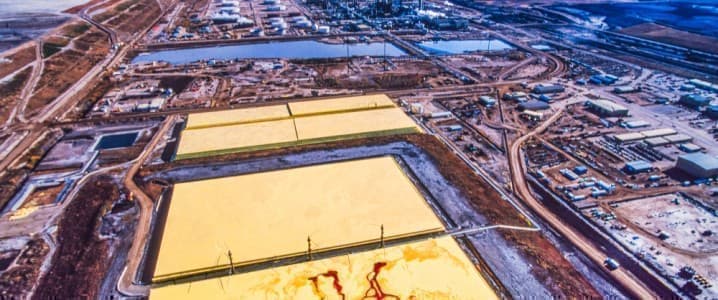In Canada, a renewable energy trend could lend itself to the oil and gas industry, with the potential for geothermal energy to help oil sands to thrive for another 30 years. Ongoing feasibility studies could provide a way for Canada to reduce its carbon emissions in line with Paris Agreement and COP26 expectations without curbing its oil production.
Canada’s Oil Sands Innovation Alliance (COSIA) has partnered with Eavor Technologies Inc. and C-FER Technologies to conduct an assessment on the potential for using geothermal energy rather than natural gas to heat water for mining, set to be complete by early 2022. The project was established to curb greenhouse gas emissions in oil production while demand for the energy source is still high.
This could be just what Canada’s oil industry needed, as oil sands typically require greater energy in the mining process due to the viscous nature of the substance, often leading to the release of higher levels of greenhouse gasses. The difficult extraction method means production often creates three to five times as many CO2 emissions per barrel of oil equivalent than other crudes.
C-FER Technologies and COSIA previously carried out an assessment with promising results, hoping a second study will scale the project to the commercial level. The preliminary study suggests it is possible to use Enhanced Geothermal Systems (EGS), through C-FER’s Eavor-Loop™, in oil sands extraction. The technology collects heat from below the earth’s surface using deep a subsurface heat exchanger, or radiator. C-FER believes it offers the potential to reduce greenhouse gas emissions by 60 kilotonnes of CO2 over a project lifecycle of three decades.
Robert Mugo, Director of Greenhouse Gases at COSIA, stated of the project, “this is an exciting step forward in the potential application of this clean energy solution and one of several avenues of innovation that COSIA and its members are pursuing to support the sustainable development of the oil sands through reducing emissions.”
Related: The Oil And Gas Industry Is Facing A $3.3 Trillion Stranded Asset Nightmare
However, this is not Canada’s first foray with geothermal power, have long discussed the potential for transferring knowledge and expertise from the oil and gas industry for the development of geothermal energy across Canada. There are around 100,000 shallow geothermal heating and cooling installations, using heat from a few meters underground, across Canada. However, the use of this technology has been limited so far due to the high set-up costs, around $20,000 per household. With the ease of availability and reliable costs of gas heating alternatives, few consumers have made the investment. However, with oil and gas prices rising and the potential for significantly reduced production within the next few decades, it could encourage the greater uptake of geothermal technologies. Following increasing international pressure from the international community to reduce carbon emissions, as well as disappointment from several canceled oil and pipeline projects with the U.S. over concerns around climate change, Canada’s oil industry finally seems to be turning towards renewable energy companies to move forward with more sustainable production methods.
Rising oil and gas prices in recent months have encouraged consumers to look towards renewable alternatives, as governments around the world offer subsidies for those looking to transition away from fossil fuels. This presents Canadian oil firms with an opportunity that has long been overlooked, the potential to incorporate renewable power into oil and gas production.
Mike Freeborn, managing director of the Canadian Imperial Bank of Commerce’s energy, infrastructure, and transition group explains, “In a strange way, these high prices have actually enabled a lot of our clients to pursue some of these transition-related issues more quickly than they otherwise would have.”
Related: How Emerging Markets Will Benefit From New Carbon Trading Rules
Demand for oil and gas is up, as we are seeing increased shortages globally, forcing the world’s oil-producing countries to ramp up production at a time when the pressure to reduce emissions and move away from fossil fuels is mounting. There is increasing interest in carbon capture and storage technologies, with Pembina Pipeline Corp. and TC Energy Corp. announcing plans to use their network of pipelines to transport and store around 20 million tonnes of CO2 annually. But now oil companies are looking for new solutions for greenhouse gas reduction in their production methods, so they can keep pumping for longer.
In addition to supporting the longevity of the oil and gas sector, merging renewable energy technologies with fossil fuel production methods could enhance training opportunities, providing those in the sector with employment prospects as the world undergoes an inevitable energy transition.
Does this mark a geothermal energy boom in Canada, as renewable energy companies finally seem to have the country’s oil firms on their side? As oil and gas costs rise alongside demand, and international pressure to curb fossil fuel production mounts, investment in geothermal powered-production methods has the potential to prolong the life of Canada’s oil industry.
By Felicity Bradstock for Oilprice.com
More Top Reads From Oilprice.com:
- JPMorgan: $80 Oil Is 'Remarkably Cheap'
- Biden's Bid To Lower Oil Prices Fails
- Aramco And Reliance Industries Scrap $15 Billion Refinery Deal


















Therefore, Canada’s endeavour to assess the potential for using geothermal energy rather than natural gas to heat water for mining for oil sands is a step in the right direction.
Dr Mamdouh G Salameh
International Oil Economist
Visiting Professor of Energy Economics at ESCP Europe Business School, London
"As oil and gas costs rise alongside demand..."
I disagree in part. I think the damage to the economy is going to periodically outweigh the supply squeeze. We should see that shortly here.